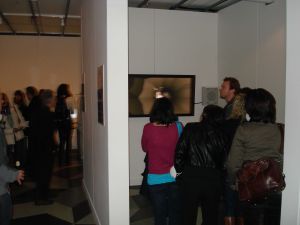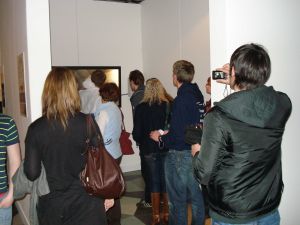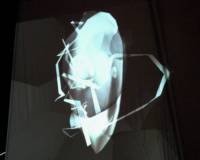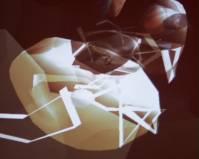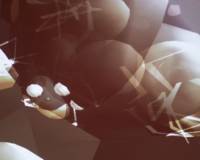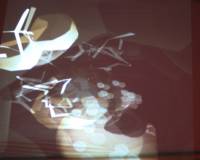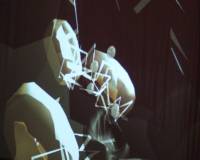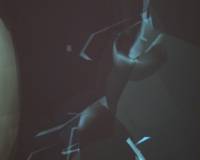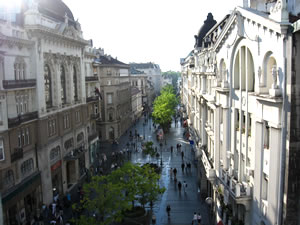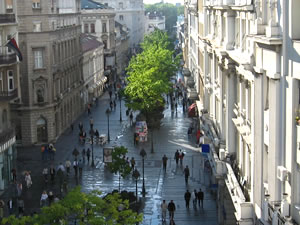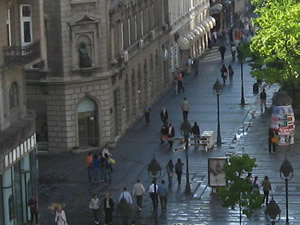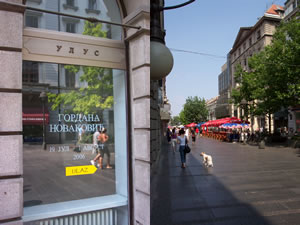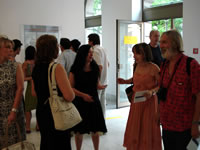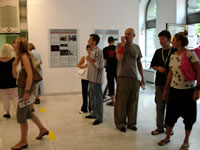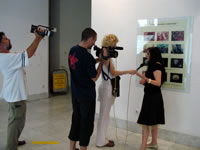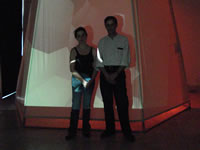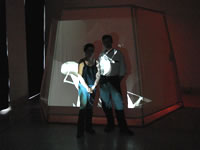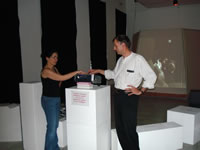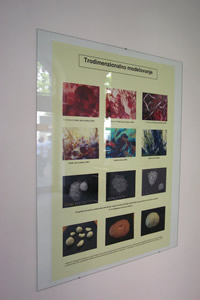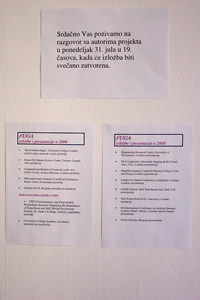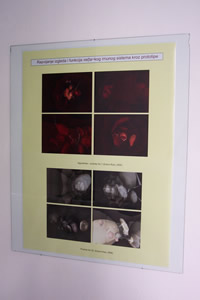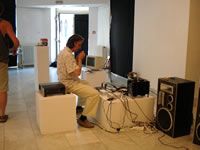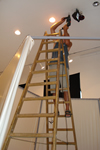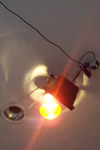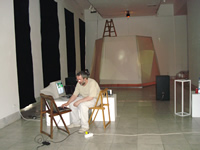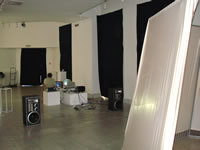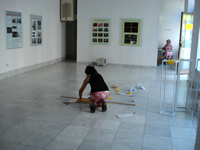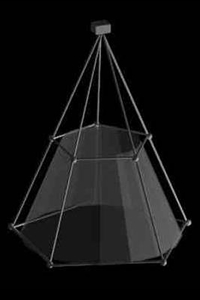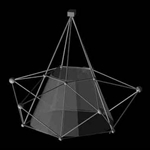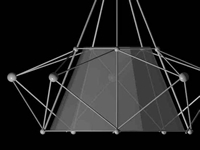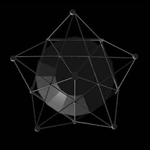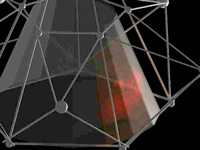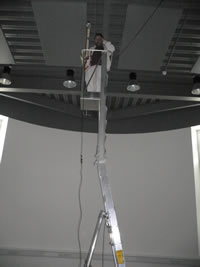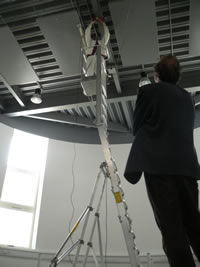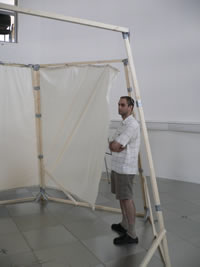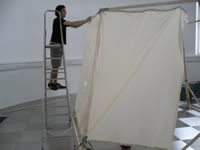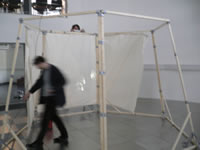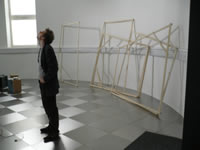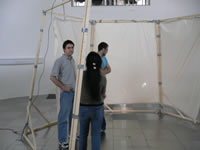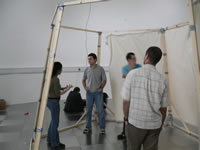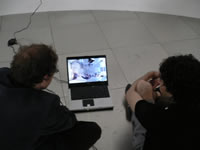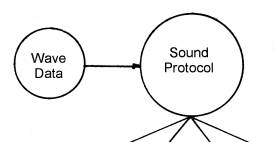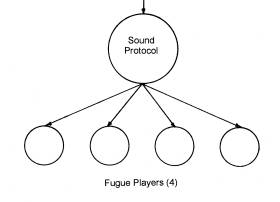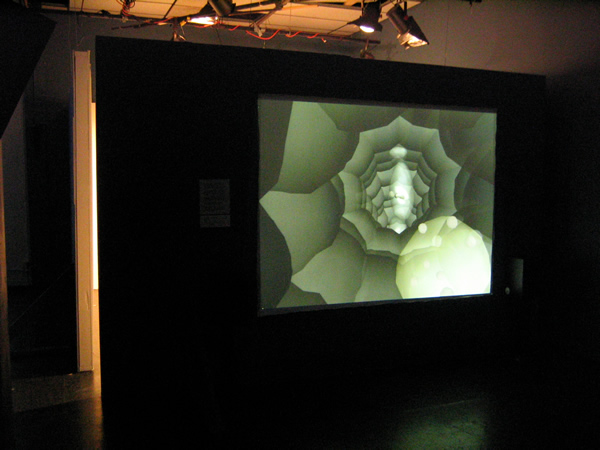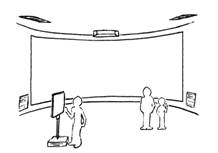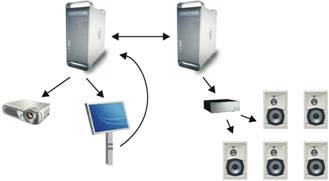| Home | About | Papers | News | Diary | Authors | Feedback | ||||||||||||||||||||||||||||||||||||||||||||||||||||||||||||||
| fugue in development
[updated July 2009] [version 0.6 June 2009] [version 0.5 June2007] [version 0.4 October 2006]| [version 0.3 July 2006] | [version 0.2 January 2006] | [version 0.1 October 2005] | [background] Fugue in Toronto Fugue at the Biomedical Simulation Lab, University of Toronto and Subtle Technologies Festival Toronto, June 2009. As a preview to the Festival Anna Dumitriu, Katja Mayer and I were invited by Professor David Steinman to present our work to researchers at the University of Toronto's Biomedical Simulation Lab, and to learn about their research. I was very impressed by their fresh and innovative approach and enjoyed lively, inspiring conversation that lasted well beyond the scheduled time, providing much food for thought. Our concept of audiovisualisation in Fugue has not been not been particularly welcomed by the community specialised in representations of scientific data. However Professor Steinman's invitation, and interest in our model raise the hope that Fugue can bring something to scientists. It would be a real pity if in spite of the rapid expansion of spectacular multimedia tools, the field of visualisation persisted in dealing with only to one of our senses at a time (mostly through images). My talk at the Symposium at Subtle Technologies titled From Fugue to Neuroplastic Arts introduced the audience to both the science and the art behind the Fugue project, reflecting on the immune system as a network. I concluded by presenting my proposition of a new kind of art - neuroplastic art - and the ways in which it can contribute to our understanding of networks (which was the theme of this year's Festival). (see also http://www.neuroplasticarts.org/ ). Dublin Fugue The exhibition entitled Infectious - Stay Away at Trinity College Dublin's Science Gallery is a new context for the Fugue project. Oddly enough, it is the first time Fugue has been exhibited within the so-called public engagement with science framework. The curatorial concept for this intriguing large-scale group show is marked by spectacular design and an imaginative theatrical script embracing an eclectic mix of scientific demonstrations in lab-like sets, along with several different art|science variations on the theme of infection. For this show, we wanted to guide the audience towards the meditative properties of the piece, and to focus on its complexity - both as an interplay between the artistic expressions within the artistic concept, and the free-running real-time generated dialogue between the four pieces of software within Fugue. We invite visitors to "watch and listen, and become attuned to the processes and rhythms that are mirroring what might be happening right now, inside your own body". We also wanted to test how an intimate set, consisting of a plasma screen in a small cubicle, would work in juxtaposition with the overall setting. (According to the audience response and the comments by the curators, it seems that it works fine.) The Science Gallery exhibitions always attract the general public in large numbers (nearly 9,000 in the first week or so of Infectious), and the three month duration of the show demanded a robust, durable and safe design. Taking all that into account, we decided to show a new integrated version of Fugue as a screen-based presentation of the free-running real-time generated sounds and visuals. Please have a look at some of the photos from the setting-up days and the opening day,
visit the exhibition website, and watch an interview with one of the artists behind Fugue.
Fugue in development Fugue is an ongoing collaborative project, based on the functioning of the human immune system. At the heart of the piece is a complex piece of scientific software, an artificial immune system algorithm, accurately mimicking the changes and cascading responses of the human immune system. The artistic concept, inspired by the musical form of the Fugue, interprets, expresses and communicates these changes through independent channels of vision, using cell-like images, and sound. In the most recent version, a large-scale interactive installation, participants engage the system in a spontaneous non-verbal dialogue, influencing both the unfolding of the immune system drama and the nature of their own experience. The Fugue project has been developed and exhibited through a series of prototypes. The texts, images, sound samples, graphs, and photos in continuation reveal the gradual evolution of the ideas and the long gestation process that led to the latest interactive installation.
About the full scale interactive installation of Fugue in Belgrade
The problem of hybridising art with science: Gordana’s impressions after the Belgrade exhibition The hybrid nature of art and science projects brings with it the excitement of stepping into unknown territory and shaping new models of artistic expression, but it also creates some difficulties in communication with exhibition venues, funding, and audiences. The ULUS Gallery, where the Fugue installation was exhibited, is in the heart of the old city, and is one of the capital’s major exhibition venues, nurturing the traditional fine art disciplines of painting, sculpture and print making, and occasionally conceptual and installation art. It offered a unique opportunity to challenge our concept by presenting the Fugue art and science project to the general public. The usual venues are of two kinds: a closed circle of specialised events with well informed audiences, which never engage with the wider art scene; or science education events, which usually target a very young audience and address scientific issues in a predominantly pedagogical manner, leaving no space for artistic concepts, and imposing constraints such as health and safety regulations.
Although ethical issues surrounding media industry models and products are fundamental to the piece, the focus for the audience, much to my surprise, turned out to be the ethics of science. One participant, for example, insisted on being told exactly what information I had collected for distribution to scientists, and for what purpose. Even a detailed explanation of how the system worked failed to convince him that it was purely an art work and not a scientific experiment. Another asked for confirmation that there was no dangerous radiation within the enclosed space of the installation. More generally, an unexpectedly high proportion of the audience hesitated before stepping into the installation space. Why? An integral part of the exhibition was a number of large illustrated posters giving details of both the artistic concept, and also the scientific background of Fugue. One possibility is that the invitation to the participants to inform themselves about these matters combined with the reddish glow of the powerful infra-red lamp and the presence of the webcam within the installation space to create some specific but mysterious scenario, reminiscent of an obscure secret laboratory. Another is that their hesitation might reflect the wider audience's views on contemporary science and its (lack of) trust in its ethical code. More generally, the observation of this phenomenon raises questions of how to communicate experimental art and science projects to various different communities, and to wider audiences. The extent to which the socio-political and cultural characteristics of a locale combine with an audience's previous knowledge to shape their experience will be another issue to explore when exhibiting Fugue elsewhere in the future.
About the Belgrade Fugue prototype Because of funding limitations, we had to postpone the original idea of creating a touch-sensitive screen for the first full scale interactive prototype. Instead, we concentrated on the spatial aspects of the piece. The sculptural design for the Belgrade version of Fugue was informed to a great extent by our experience with the Infonoise installation [www.infonoise.net], as well as by several years of researching theoretical findings across disciplines. As explained below, we have learned that an environment that avoids the use of rectangular projections (regardless of the number of screens employed) produces an entirely different experience and response. The computer generated visuals of Fugue are therefore back-projected by an LCD projector onto the walls of a custom-built hexagonal pyramid-shaped sculptural enclosure designed by Zoran Milkovic. The shape suggests the positioning of the participant within the space of a lymphatic vessel, providing an experience of full physical immersion rather than just simulating the conditions for such an experience. This also enables us to avoid the overexploited concept of using avatars. The participant is situated within an installation space that serves as a membrane that unifies the virtual world and the enclosed interactive environment.
Artistic concept The original artistic concept has been developed to match the character of the physical installation. The perceptual flow of events in Fugue is rather slow in comparison to the omnipresent, rapid, hyper-sequential and violent audio-visual forms that fracture perception and disperse consciousness; Fugue is designed to provide the participant with the time necessary for a profound, complex inter-sensory experience. The visuals interpret and reveal the character and essence of the cellular and hormonal processes driving the algorithm’s response to the presence and response of the participant. The sound, by the Australian composer Rainer Linz, appears as a ‘mental soundscape’, a resonance of the functioning of the immune system. It does not originate solely from the virtual world; it is dependent on the participants' movement through the physical space, and exhibits an unstable and fugal relationship with the visual sensations. Visual Concept The visual aspects of Fugue took shape many years ago, in a long series of abstract paintings with a strong cellular theme. In Fugue, the focus is on understanding and applying the principles of biological processes rather than simply creating 'beautiful imagery', or re-representing scientific findings as visualizations or sonifications. In order to underpin the focus on processes, the conventional �real� images of the lymphatic system have been reduced to symbols. I produced clay models to form the basis for Fugue�s visual language; the roughness of the clay was deliberately retained when the models were digitised. The other components, including the lymphatic vessel, have also been left in a basic, rather sketch-like form, and the colour has been reduced to a monochromatic grey scale. The models were scanned in 3D by the computer scientist Anthony Ruto, and used to prepare wireframe models that could then be rendered appropriately. (Please also see inspiration and creation in the background section.) Click here for some examples of the screen images Sound Concept Fugue's sound software is based around a series of customised audio players ("Fugue Players") that respond in real time to changes within the artificial immune system. An array of variables is passed to the sound system at regular intervals, representing a 'snapshot' of what is happening inside the artificial immune system at that particular time. The data array, or 'data state' of the artificial immune system is compared to its previous stored counterpart to detect which values have changed in the meantime. Any new values are passed to handler routines which parse and analyse the artificial immune system data state and initiate a suitable change in the sounding process. An example of a data parsing procedure is to register changes in the direction of growth of particular immune system cells over time. Currently only vocal samples are used in the sound design; they are stored as 16 bit, 44.1kHz mono samples. The customised audio player concept challenges the phonographic paradigm, of which audio CDs or internet streaming files are examples. Here, instead of the mechanical playback of fixed sound data from a disk or file, the audio player combines and renders source wavetable information in real time, providing a listener with the possibility of a unique and customisable listening experience. (A detailed explanation by Rainer is given in 'A brief description of the Sound Software for Fugue by Rainer Linz' in version 0.3)
Interactivity The interaction in Fugue is controlled by sensing the presence and movements of the participants. This is done using a system developed by Richard Newcombe. An infra-red lamp is mounted 6m above the enclosure, and an adjacent camera sensitive to infra-red light sends a video stream to a custom-designed software package which uses a combination of adaptive particle filtering and real-time computation of visual flow to extract the information specified by the artist. This information is then passed to the artificial immune system software where it modulates the development of the central algorithm, influencing both the visuals and the sound, and reflexively engaging the participant. Software Concept The core immune system algorithm, developed by the computer scientist Peter Bentley in the context of artificial intelligence, has now become a form of artificial life, an open system that endlessly changes and evolves, creating emergent interactions at different levels in a state of constant becoming. The artificial immune system software creates the dynamics of the virtual immune system drama. It also constructs and implements the architecture of Fugue by providing the functional structure for the communication channels between the visuals and the sound. And finally, its embedding within a fugue-like structure enables it not only to represent the processes involved, but also at the same time to paint a larger picture of the role of the immune system in the functioning of the human body (and mind). Photos by: Rainer Linz, Gordana Novakovic and Ksenija Livada |
||||||||||||||||||||||||||||||||||||||||||||||||||||||||||||||
|
[updated July 2006] | [top] Fugue in Belgrade After a period of research, that has stretched over one year and a half, we are in the phase of intense preparations for the first full scale interactive version of Fugue, that will be premiered in ULUS Gallery in Belgrade, 19 July – 1 August 2006. During this period of time, in parallel with research process, we have exhibited and presented intensively prototypes. Working toward a ‘tuneable’ interactive piece, which has been one of our goals, the interaction in Fugue is controlled by sensing the presence and movements of the participants. This is done using a system developed for Fugue by Richard Newcombe at the Department of Computer Science, University of Essex. An overhead camera sensitive to infra red light sends a video stream to a custom-designed software package which uses a combination of adaptive particle filtering and real-time computation of visual flow to extract the information specified by the artist. This information is then passed to the AIS software where it modulates the development of the central algorithm, influencing both the visuals and the sound. The sculptural design for the installation, envisaged by the artist, has been developed by Zoran Milkovic. He is currently working on producing the final construction in Belgrade. The prototype has been built up following his sketches:
The project is grateful to the Department of Computer Science at the University of Essex for the provision of the space, equipment, and technical resources to support the development and testing of the final prototype of the full scale exhibition in Belgrade. Special thanks go to Professor Owen Holland, and to Renzo De Nardi.
A brief description of the Sound Software for Fugue by Rainer Linz This is a rather technical outline of some aspects of Fugue's sound software. While it may not be for everyone I hope it can assist, in some small way, the listening experience. To begin, Fugue's sound software is based around a series of customised audio players ("Fugue Players") that respond in real time to changes within the Artificial Immune System (AIS). The sound software is designed to run on a separate computer, which is networked with the AIS's computer, although both systems will run on the same machine and have done so in presentations to date. The audio players are part of a larger collection of java classes making up the Fugue audio system. These include Server, Sound Protocol and Wave Data classes. I also wrote a Client class to simulate the AIS for development and testing. The relationship between the sound System classes is shown below. What follows is a brief description of each.
Client With the distances involved in our collaboration we decided that I would use a simulation of the AIS in Melbourne, to establish a way of working independently of the Fugue hardware which was situated in London. Updates to the sound software could be emailed and tested on the system there. In London, output data from the AIS could be captured into a text file while it was running, and emailed to me. My client software then, was designed to read this authentic AIS output and send the information to the Sound Server at regular intervals just as the AIS would.
Sound Server
Sound Protocol The handler routines are the composition and performance procedures for Fugue's sound. The role of the Sound Protocol class is to parse and analyse the AIS data state and initiate a suitable change in the sounding process. The logic here is infinitely extensible and serves to bind AIS events to relevant sound processes. An example of a data parsing procedure is to register changes in the direction of growth of particular immune system cells over time.
Wave Data class
Fugue Player The functionality includes start, stop, volume and pan controls, as well as dynamically loading and sequencing wavetable information. The player has an internal sound buffer making it useful for direct sample manipulation. A granular synthesis provision is to be added in future. While four Fugue Players are shown in the diagram, up to 16 may be used.
Remarks The customised audio player concept challenges the phonographic paradigm, of which audio CDs or internet streaming files are examples. Here, instead of the mechanical playback of fixed sound data from a disk or file, the audio player combines and renders source wavetable information in real time, providing a listener with the possibility of a unique and customisable listening experience. |
||||||||||||||||||||||||||||||||||||||||||||||||||||||||||||||
|
[updated January 2006] | [top] A year ago, in the early stage of our ongoing-project, we stated:
A period of time developing the twofold concept of an artwork and a scientific tool was summarized in the in the paper titled: Fugue: an Interactive Immersive Audiovisualisation and Artwork using an Artificial Immune System. At this stage, our research has shifted to the artistic facet. Gerald Edelman's Bright Air, Brilliant Fire , together with Richard Wurtman's articles on the influence of light on the human body opened a new path for this research. Perhaps the most important recent reading has been Shaun Gallagher's interdisciplinary book How the Body Shapes the Mind (2005). Firmly grounded in the philosophy of M. Merleau-Ponty, and current scientific achievements across disciplines, it opens new views on consciousness, particularly embodiment, the complexity and inter-sensory nature of perception. Body in dialogue with AI Liberation from the exclusivity of the conventional 'white cube' gallery space offers the possibility of situating an artwork in various environments, and provides the potential of assessing it as a natural, yet to a great extent controlled, experimentation space. In the groundbreaking The Talking Heads Experiment in 1999, a scientific laboratory, in collaboration with artists and art curators, was transposed into an art event, and the general public was invited to actively participate in scientific experimentation with AI. We intend to make transparent the research process of creating a work of art, rather than transforming a scientific laboratory into a gallery, or exhibiting space. Fugue project has opened the process of building an interactive installation that applies AI, conceptualized as an artificial entity, into the space open for active artistic and scientific participation as well as for the wider audience over the internet. In the recent emerging diverse forms of bio-art such as works by Eduardo Kac's and Oron Catts as examples - the ethical issue is one of the focal questions. Yet again, the focus is mostly on the technology and the ethics of treating living matter as a means of artistic expression; a challenging, even bizarre interface. Our focus shifts from the technology and interface, although carefully designed, to the body of a participant. I ask myself the question: what happens in the participant's body; a body defined in terms of existential phenomenology: of no distinction between body and mind, in the constant process of becoming through interaction with the world, the body that �I am', to paraphrase M-Ponty. Communicating with the senses We have already conceptualized the current, second prototype, which fully integrates the sound elements into AIS mediated visual modules, well grounded in the role of hearing in visual perception. It was first presented and exhibited at NewForms05: Ecologies festival and conference, Vancouver , September 2005.
In the next research phase, we intend to apply previous experiences with a large-scale customized screen Infonoise working toward more complex inter-sensory experiences within an interactive environment. We plan to experiment with using so-called �artificial skin', usually developed for robots, as a material for building the installation. This will create an intelligent interface capable of memorizing and learning as another AI element to be incorporated into the complex architecture of the Fugue . From the experience with the Infonoise installation, we have learned that the environment that differs from the rectangular projection, regardless of the number of screens applied, brings an entirely different experience and response. The element of touch is expected to induce spontaneity, curiosity and a more direct, intuitive, non-cerebral participation. On the other hand, this would provide data for the AI that would induce evolving changes within it, rather then responding in a predefined manner each time. Our quite ambitious quest for parameters for �calibrating' an interactive artwork continues. We will further research across disciplines the scientific knowledge on the influence of technology on the human body alongside developing the artwork through prototypes. The anticipated long-term outcome will be the first experimental immersive environment with a �product specification', which in this case will be written in terms of the impact on the participants' body. References [1] P. J. Bentley, G. Novakovic, A. Ruto (2005). Fugue: An Interactive Immersive Audiovisualisation and Artwork Using an Artificial Immune System ; Proceedings of ICARIS 2005, Artificial Immune Systems: 4th International Conference, Banff , Canada , August 2005 [2] Edelman G, Bright Air, Brilliant Fire , (1003) Basic Books, Reprint edition, 1993 [3] Gallagher S, How the Body Shapes the Mind (2005). Oxford University Press (March 2005. |
||||||||||||||||||||||||||||||||||||||||||||||||||||||||||||||
[updated October 2005] | [top] Summary Fugue is the result of a collaboration between artists, new music composer and computer scientists. The result is an on-going project which provides a new way of communicating complex scientific ideas to any audience. Immersive virtual reality and sound provide an interactive audiovisual interface to the dynamics of a complex system � for this work, an artificial immune system. Alongside with providing the greatest immersive effect currently available, this technology offers the potential to control and calibrate particular audio-visual elements. The aesthetics of the Fugue is emergent, based upon the essential, fundamental and hidden beauty of the organic processes manifested through the dynamics of the real-time generated, unpredictable algorithm. The piece is set up as an interaction between a virtual (artificial) immune system and a human participant. Participants are able to see and interact with immune cells flowing through a lymphatic vessel and understand how the complex dynamics of the whole are produced by local interactions of viruses, B cells, antibodies, dendritic cells and clotting platelets. The sound, envisaged as a �mental soundscape', a resonance of the function of immune system in the body, provides a major channel for interaction. By overlaying and modulating the sonic pulsation, cycles - such as circadian rhythms, or other inputs such as stress level, will be introduced in the future. The Artificial Immune System will �inhabit' the virtual space of the master server computer at the CS UCL that will run the Artificial Immune System continually, providing the possibility of being displayed on different interfaces.
Art and Science Artists and scientists are both concerned with understanding the world and our being in the world; but while the view of the scientist is rooted in consensus and endeavours towards objectivity, the artist emphasises the values of the personal and subjective investigation of philosophical questions. Such a dichotomy suggests potential conflict: does the participation of an artist in the communication of science run the risk of introducing some bias antithetical to the very idea of science? And if so, can this potential conflict be managed satisfactorily within the collaborative process? Taken together, these two questions raise a wide range of issues, and as yet there are no definitive answers. The Fugue Project aims to frame and focus the questions in the context of transdisciplinary collaboration in the area of representing the functional dynamics of one of the most complex systems known � the human immune system. This will be achieved by the creation of an immersive virtual reality immune system, which enables participants to interact with and understand various cellular behaviours inside a lymphatic vessel. The hope is that the information uncovered by this research will help to structure future more comprehensive investigations of these fascinating and important issues, for art and science. We propose that the best way of enabling both scientists and non-scientists to understand a complex functioning system is not just to present it to him as a spectacle, but to engage him as a participant, and to enable him to interact with the system in a multisensory way, directly appreciating cause and effect, variability, intrinsic dynamics, periodicity, and so on. To achieve this, direct input from an artist and a composer is used to guide the visual and audio experience. In other words: we propose to exploit artists' knowledge of the relation between interactivity and perception, and harness it in the communication of scientific complexity.
Audiovisualisation Audiovisualisation offers significant advantages for understanding hugely complex systems: it offers a much wider bandwidth than vision alone, and engages both serial and parallel modes of perception. In addition, the intention is to explore the potential of contemporary Virtual Reality technologies for enabling users to actively engage with the production of phenomena, rather than merely observing them passively, within a custom designed virtual reality environment. The user will be able to control certain parameters of the modelled immune system, and will also be able to choose the particular function, particle, or interaction to follow. There are good theoretical reasons pointing in this direction, in particular Merleau-Ponty's analysis of the role of the ear in visual perception. As Dombois, the author of Planetary Seismology, wrote in 2001: �From philosophical research (�) we can learn that the eye is strong in recognising structure, surface and steadiness. (�..) Now at the same time philosophy finds the ear strong in the recognition of time, dynamics of a continuum and tensions between remembrance and expectation.' Fugal structure The basic concept tests the form of the interaction between the sound and the vision in a way that is inspired by the complexity of one of the greatest musical forms: the art of fugue. The art of fugue is a highly disciplined form of composition of complex structure and exact relationship of parts. The title � Fugue � serves as a metaphor for the transdisciplinary nature of the project, and for the method applied: of inter-weaving the different perspectives of artists and scientists, different aesthetics, various skills and expertise, and personal philosophies, and uniting them into evolving poly-phonic synergy. The emergent, evolving nature of Artificial Immune System algorithm, repetition as a succession of variations of �events', and the complex structural and functional interrelationship of the particular elements and processes that can be related to the counterpoint, was one of the inspirations for the fugue concept. The Artificial Immune System software creates the dynamics of the virtual immune system drama, and also constructs and implements the architecture of the Fugue by providing the functional structure for the communication channels between the visuals and the sound. On the other hand, this method is well grounded in the already successfully applied artistic method of interweaving, cross-connecting different specialists and specialisms, in an effective cross-disciplinary framework for the emergence of synergy through collaboration; a method resembling the structure of the fugue. In parallel with providing the functional structure for the communication channels between the visuals and the sound, the Artificial Immune System algorithm is a bridge between the scientific and artistic aspect of the project. To establish an appropriate balance between art and science, we have been working closely together on both experimentation and evaluation throughout the whole research process, integrating our own assessments with the external feedback. (This method also distinguishes this concept from the mere application of entertainment industry oriented software packages for audiovisualisation.) Finally, the fugue structure helps us to achieve one of the major aims, by not only rep-resenting all the processes involved, but also at the same time painting a larger picture of the role of the immune system in the functioning of the human body and mind. This will illustrate the immune system's intimate interconnectedness with the total sum of particulars that constitute each human being. This approach affirms holism as one of the fundamental principles of transdisciplinarity, as seen for example in the neurophenomenology of Varela, Maturana, and Thompson, and the biology of Margulis and Goodwin. Because are working towards facilitating a better understanding of the function of the immune system, rather than simply creating 'beautiful imagery', much of our work has been concentrated on processes. The aesthetics of the Fugue is emergent, based upon the essential, fundamental and hidden beauty of the organic processes manifested through the dynamics of the real-time generated, unpredictable Artificial Immune System. Hardware The immediate target for Fugue is to move from the current desktop-based demonstrator to a full-sized system capable of withstanding the rigors of exhibitions. Figure 1 provides an illustration of a possible exhibition installation. An overhead LCD projector and surround-sound speakers will provide the main output, to be experienced by several participants simultaneously. One or more free-standing rotatable LCD �windows� will also be placed in the arena (the exact number depending on the floor area available). These will provide individual views into the same virtual world and permit views from different players in the system (i.e., from a B-cell, or a virus). By rotating the window, the participant rotates their view within the virtual world, enabling interactive control of their immersive experience. The LCD windows will be constructed for the Fugue project and will comprise 17 inch LCD monitors mounted in metal stands, rotatable through at least 300 degrees, with rotation measured by optical sensors and fed back to the server.
Two servers are used to run the Fugue software: a graphics server, which calculates the artificial immune system and corresponding three-dimensional visualisation, and a sound server to calculate corresponding audio. The servers are networked together. Communication between the servers is through TCP/IP. Output from the graphics server feeds to an LCD projector (and the free-standing screens if installed). Output from the sound server feeds to a surround-sound amplifier, which is linked to a minimum of four speakers. Input from sensors such as the window rotation sensors is fed to the graphics server, see figure 2.
Bibliography [1] Brown, M. H. and Hershberger, J. (1991). Color and Sound in Algorithm Animation (Technical Report No. 76a). DEC Systems Research Center . [2] D. Cox, 1988 : Renaissance Teams and Scientific Visualization: A Convergence of Art and Science, Collaboration in Computer Graphics Education, SIGGRAPH '88 Educator's Workshop Proceedings [3] D. Cox, 1989: The Tao of Postmodernism: Computer Art, Scientific Visualization, and Other Paradoxes, ACM SIGGRAPH '89 Leonardo: International Journal of Art, Tech-nology and Science Supplemental Issue [4] F. Dombois, 2001: Using Audification in Planetary Seismology, Proceedings of the 2001 International Conference on Auditory Display, Espoo [5] Christian Jacob, Julius Litorco and Leo Lee 2004. Immunity through swarms: agent-based simulations of the human immune system. In Proc. of the Third International Con-ference on Artificial immune Systems (ICARIS 2004), Catania , Sicily . pp. 400-412. [6] S. Kleinstein, J. Pal Singh, Philip E. Seiden: Putting limits on selection and mutation in a simulation of the humoral immune response, Pacific Symposium on BioComputing. 1999 [7] Brian Goodwin, 2001: How the Leopard Changed Its Spots : The Evolution of Complex-ity; Princeton University Press [8] O. Grau, 2000: Ancestors of the virtual, historical aspects of virtual reality and its con-temporary impact,Thirtieth International Congress of the History of Art, London [9] L. Margulis, D. Sagan, 1986: Microcosmos: Four Billion Years of Evolution from Our Microbial Ancestors, University of California Press [10] H. Maturana and F. Varela, 1992: The Tree of Knowledge: The Biological Roots of human understanding,The MIT Press [11] M. Merleau-Ponty, 2002: Phenomenology of Perception, Routledge Classics [12] Ruiz M., Buxton, B.F., Douros I., Treleaven, P.C., "Web-based Software Tools for 3D Body Database Access and Shape Analysis", Scanning 2002 Proceedings, Paris, May 2002. [13] New Scientist Editorial 2005. Bring back bugs to finish off allergies. We have eliminated so many childhood diseases and risky micro-organisms that our immune systems are un-dereducated - how do we redress the balance? New Scientist 2495. 16 April 2005 [14] Nicosia , G., Cutello, V., Bentley, P. J. and Timmis J. (Eds) (2004) Artificial Immune Systems. Proceedings of the Third International Conference (ICARIS 2004). Lecture Notes in Computer Science 3239. Springer-Verlag. ISBN 3-540-230 |
||||||||||||||||||||||||||||||||||||||||||||||||||||||||||||||
|
[updated 2005] | [top] Background to the Project The concept for the Fugue project emerged as a spin-off from the work on the Art Council England-funded prototype for Algorithmica , a large-scale art work partly inspired by the immune system. When Dr. Bentley, a specialist in artificial immunology and collaborator on the project, showed the visual model produced for the art work to some practicing immunologists, their strong interest suggested the possibility of developing a new method for the visualisation of the immune system, giving equal weight to art and science. The prototype was presented to several varied audiences immediately after its completion. This instant positive response generated our strong enthusiasm for developing a new project � an immune system audiovisualisation. Soon after this, Dr. Julie Mcleod, a consultant on immunology, joined the core team. The human immune system is so complex that it is currently impossible to produce a tractable model of the whole. Nevertheless, computational models are increasingly been seen as important tools to aid our scientific understanding. Separate from immunobiology, the field of artificial immune systems has grown dramatically in the last five years. Artificial immune systems algorithms are computer programs modelled on different aspects of the human immune system and used to tackle a wide variety of problems, from computer virus detection to data mining, to robot control. Additionally, in recent years issues of public health (from simple allergies to the expansion of AIDS and recent global epidemics of extremely dangerous flu variations) have led to in-creased and widespread public interest in the immune system. There is a clear need for the lay population to be much better informed about the operation of the one of the most complex and enigmatic biological systems. Audiovisualisation is still a new methodology for presenting scientific findings. Only one virtual reality approach, Planetary Seismology (a Virtual Reality audio/visual representation of seismic phenomena) produced by the German scientist Dombois in 2001, is available for participants at present. Only a handful of immune system visualisations currently exist. They have all been produced exclusively by scientists (Steven Kleinstein, IMMSIM, 1999; Christian Jacob, 2004), and the presentational styles are barely accessible to non-experts. (For example, IMMSIM uses a very abstract 2-dimensional lattice representation based on cellular automata.) To date, these visualisations have been presented only within a closed circle of scientists and have not been released for the general public. Inspiration
Creation
|
||||||||||||||||||||||||||||||||||||||||||||||||||||||||||||||
 |
||||||||||||||||||||||||||||||||||||||||||||||||||||||||||||||
|
||||||||||||||||||||||||||||||||||||||||||||||||||||||||||||||
